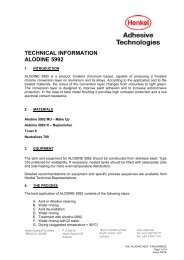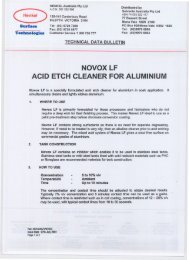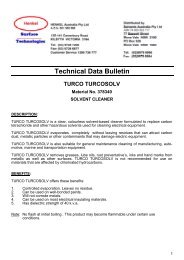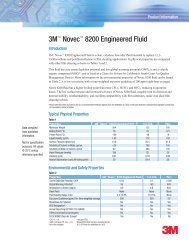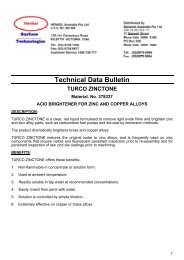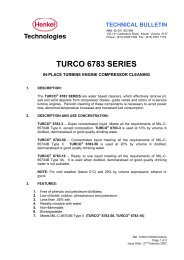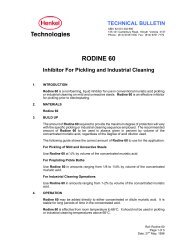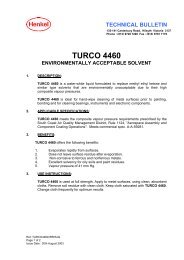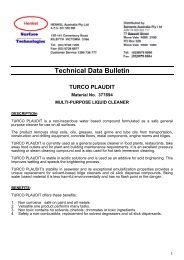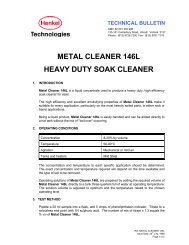Toluene - Solvents Australia
Toluene - Solvents Australia
Toluene - Solvents Australia
- No tags were found...
You also want an ePaper? Increase the reach of your titles
YUMPU automatically turns print PDFs into web optimized ePapers that Google loves.
Material Safety Data Sheet<strong>Toluene</strong>See Chapter 13 for information on disposal.Protective Measures:Clean Up Methods:Additional Advice:Isolate hazard area and deny entry to unnecessary or unprotected personnel.Stay upwind and keep out of low areas.Shut off leaks, if possible without personal risks. Remove all possible sourcesof ignition in the surrounding area. Use appropriate containment (of productand fire fighting water) to avoid environmental contamination. Prevent fromspreading or entering drains, ditches or rivers by using sand, earth, or otherappropriate barriers. Attempt to disperse the vapour or to direct its flow to asafe location for example by using fog sprays. Take precautionary measuresagainst static discharge. Ensure electrical continuity by bonding andgrounding (earthing) all equipment. Ventilate contaminated area thoroughly.For large liquid spills (> 1 drum), transfer by mechanical means such asvacuum truck to a salvage tank for recovery or safe disposal. Do not flushaway residues with water. Retain as contaminated waste. Allow residues toevaporate or soak up with an appropriate absorbent material and dispose ofsafely. Remove contaminated soil and dispose of safely.For small liquid spills (< 1 drum), transfer by mechanical means to a labelled,sealable container for product recovery or safe disposal. Allow residues toevaporate or soak up with an appropriate absorbent material and dispose ofsafely. Remove contaminated soil and dispose of safely.Notify authorities if any exposure to the general public or the environmentoccurs or is likely to occur. Local authorities should be advised if significantspillages cannot be contained. The vapour is heavier than air, spreads alongthe ground and distant ignition is possible. Vapour may form an explosivemixture with air. See Chapter 13 for information on disposal.7. HANDLING AND STORAGEGeneral Precautions:Handling:Avoid breathing vapours or contact with material. Only use in well ventilatedareas. Wash thoroughly after handling. On guidance on selection of personalprotective equipment see Chapter 8 of this Material Safety Data Sheet. Usethe information in this data sheet as input to a risk assessment of localcircumstances to help determine appropriate controls for safe handling,storage and disposal of this material.Avoid contact with skin, eyes, and clothing. Extinguish any naked flames. Donot smoke. Remove ignition sources. Avoid sparks. Even with propergrounding and bonding, this material can still accumulate an electrostaticcharge. If sufficient charge is allowed to accumulate, electrostatic dischargeand ignition of flammable air-vapour mixtures can occur. Be aware ofhandling operations that may give rise to additional hazards that result fromthe accumulation of static charges. These include but are not limited topumping (especially turbulent flow), mixing, filtering, splash filling, cleaningand filling of tanks and containers, sampling, switch loading, gauging, vacuumtruck operations, and mechanical movements. These activities may lead tostatic discharge e.g. spark formation. Restrict line velocity during pumping inorder to avoid generation of electrostatic discharge (
Material Safety Data Sheet<strong>Toluene</strong>o-Cresol, withhydrolysis increatinine in urine<strong>Toluene</strong> in UrineSampling time: End ofShiftSampling time: End ofshift0.3 mg/g ACGIH BEL (01 2010)0.03 mg/l ACGIH BEL (01 2010)Exposure Controls:Personal ProtectiveEquipment:Respiratory Protection:Hand Protection:Eye Protection:Protective Clothing:Monitoring Methods:The level of protection and types of controls necessary will vary dependingupon potential exposure conditions. Select controls based on a riskassessment of local circumstances. Appropriate measures include: Use sealedsystems as far as possible. Adequate explosion-proof ventilation to controlairborne concentrations below the exposure guidelines/limits. Local exhaustventilation is recommended. Firewater monitors and deluge systems arerecommended.Personal protective equipment (PPE) should meet recommended nationalstandards. Check with PPE suppliers.If engineering controls do not maintain airborne concentrations to a levelwhich is adequate to protect worker health, select respiratory protectionequipment suitable for the specific conditions of use and meeting relevantlegislation. Check with respiratory protective equipment suppliers. Whereair-filtering respirators are suitable, select an appropriate combination ofmask and filter. Select a filter suitable for organic gases and vapours [boilingpoint >65 °C (149 °F)] meeting EN14387. Where air-filtering respirators areunsuitable (e.g., airborne concentrations are high, risk of oxygen deficiency,confined space) use appropriate positive pressure breathing apparatus.Where hand contact with the product may occur the use of gloves approvedto relevant standards (e.g. Europe: EN374, US: F739, AS/NZS:2161) madefrom the following materials may provide suitable chemical protection:Longer term protection: Viton. Incidental contact/Splash protection: Nitrilerubber. Suitability and durability of a glove is dependent on usage, e.g.frequency and duration of contact, chemical resistance of glove material,glove thickness, dexterity. Always seek advice from glove suppliers.Contaminated gloves should be replaced.Personal hygiene is a key element of effective hand care. Gloves must only beworn on clean hands. After using gloves, hands should be washed and driedthoroughly. Application of a non-perfumed moisturizer is recommended.Chemical splash goggles (chemical monogoggles).Chemical resistant gloves/gauntlets. Where risk of splashing or in spillageclean up, use chemical resistant one-piece overall with integral hood. Wearantistatic and flame retardant clothing.Monitoring of the concentration of substances in the breathing zone ofworkers or in the general workplace may be required to confirm compliancewith an OEL and adequacy of exposure controls. For some substancesbiological monitoring may also be appropriate. Examples of sources ofrecommended exposure measurement methods are given below or contactthe supplier. Further national methods may be available. National Institute ofOccupational Safety and Health (NIOSH), USA: Manual of Analytical Methods,http://www.cdc.gov/niosh/nmam/nmammenu.html. Occupational Safetyand Health Administration (OSHA), USA: Sampling and Analytical Methodshttp://www.osha.gov/dts/sltc/methods/index.html Health and SafetyExecutive (HSE), UK: Methods for the Determination of HazardousSubstances, http://www.hse.gov.uk/pubns/mdhs/index.htm Institut fürVersion: 5.3Effective Date: 20 th August 2012Product: <strong>Toluene</strong>Page: 6 of 11
Material Safety Data Sheet<strong>Toluene</strong>Conditions to Avoid:Materials to Avoid:HazardousDecomposition Products:Sensitivity to StaticDischarge:Avoid heat, sparks, open flames and other ignition sources. Prevent vapouraccumulation.Strong oxidising agents.Thermal decomposition is highly dependent on conditions. A complexmixture of airborne solids, liquids and gases, including carbon monoxide,carbon dioxide and other organic compounds will be evolved when thismaterial undergoes combustion or thermal or oxidative degradation.Yes, in certain circumstances product can ignite due to static electricity.11. TOXICOLOGICAL INFORMATIONBasis for Assessment:Acute Oral Toxicity:Acute Dermal Toxicity:Acute Inhalation Toxicity:Skin corrosion/irritation:Serious eyedamage/irritation:Respiratory Irritation:Sensitisation:Repeated Dose Toxicity:Germ cell mutagenicity:Carcinogenicity:Information given is based on product data.Low toxicity: LD50 >2000 mg/kg , Rat Aspiration into the lungs whenswallowed or vomited may cause chemical pneumonitis which can be fatal.Low toxicity: LD50 >2000 mg/kg , RabbitLow toxicity: LC50 >20 mg/l / 4 hours, Rat Classified as harmful by theEuropean Commission.High concentrations may cause central nervous system depression resultingin headaches, dizziness and nausea; continued inhalation may result inunconsciousness and/or death.Irritating to skin.Moderately irritating to eyes (but insufficient to classify).Inhalation of vapours or mists may cause irritation to the respiratory system.Not a skin sensitiser.Central nervous system: repeated exposure affects the nervous system.Effects were seen at high doses only.Respiratory system: repeated exposure affects the respiratory system. Effectswere seen at high doses only.Visual system: may cause decreased color perception. These subtle changeshave not been found to lead to functional colour vision deficits.Auditory system: prolonged and repeated exposures to high concentrationshave resulted in hearing loss in rats. Solvent abuse and noise interaction inthe work environment may cause hearing loss.Not mutagenic.Not carcinogenic in animal studies.MaterialCarcinogenicity Classification<strong>Toluene</strong>ACGIH: Not classifiable as a human carcinogen<strong>Toluene</strong> IARC: Not classifiable as to carcinogenicity ACGIH (2003)<strong>Toluene</strong>GHS / CLP: NO carcinogenicity classificationReproductive andDevelopmental Toxicity:Additional Information:Causes foetotoxicity in animals at doses which are maternally toxic.Does not impair fertility.Exposure to very high concentrations of similar materials has been associatedwith irregular heart rhythms and cardiac arrest. Abuse of vapours has beenassociated with organ damage and death.Version: 5.3Effective Date: 20 th August 2012Product: <strong>Toluene</strong>Page: 8 of 11
Material Safety Data Sheet<strong>Toluene</strong>12. ECOLOGICAL INFORMATIONAcute ToxicityFish:Aquatic crustacea:Algae/aquatic plants:Chronic ToxicityFish:Aquatic crustacea:Mobility:Persistence/degradability:Bioaccumulation:Other Adverse Effects:Toxic: 1 < LC/EC/IC50 1.0 - 1.0 -
Material Safety Data Sheet<strong>Toluene</strong>IATA (Country variations may apply)UN number: 1294UN proper shipping name: <strong>Toluene</strong>Class / Division: 3Packing group:II15. REGULATORY INFORMATIONThe regulatory information is not intended to be comprehensive. Other regulations may apply to thismaterial.SUSMP Schedule: 6Chemical Inventory StatusAICS:Listed.DSL:Listed.INV (CN):Listed.ENCS (JP): Listed. (3)-2TSCA:Listed.EINECS: Listed. 203-625-9KECI (KR): Listed. 97-1-298KECI (KR): Listed. KE-33936PICCS (PH):Listed.16. OTHER INFORMATIONR-phrase(s)R11: Highly flammable.R38: Irritating to skin.R48/20:Harmful: danger of serious damage to health by prolonged exposure throughinhalation.R63: Possible risk of harm to the unborn child.R65: Harmful: May cause lung damage if swallowed.R67: Vapours may cause drowsiness and dizziness.MSDS Version Number: 5.3MSDS Effective Date: 20.08.2012MSDS Revisions:A vertical bar (|) in the left margin indicates an amendment from theprevious version.MSDS Regulation:Uses and Restrictions:Raw material for use in the chemical industry.Use only in industrial processes.Version: 5.3Effective Date: 20 th August 2012Product: <strong>Toluene</strong>Page: 10 of 11




